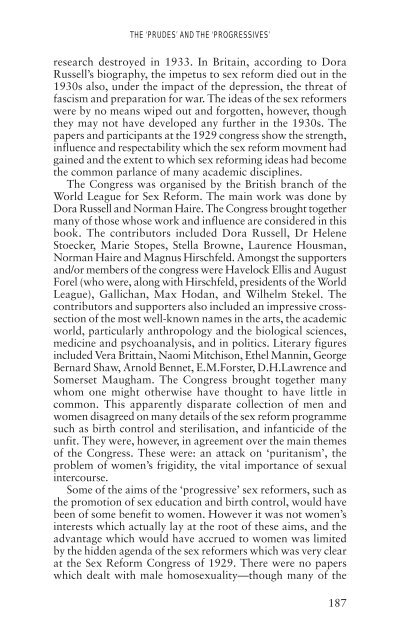The Spinster and Her Enemies - Feminish
The Spinster and Her Enemies - Feminish
The Spinster and Her Enemies - Feminish
You also want an ePaper? Increase the reach of your titles
YUMPU automatically turns print PDFs into web optimized ePapers that Google loves.
THE ‘PRUDES’ AND THE ‘PROGRESSIVES’<br />
research destroyed in 1933. In Britain, according to Dora<br />
Russell’s biography, the impetus to sex reform died out in the<br />
1930s also, under the impact of the depression, the threat of<br />
fascism <strong>and</strong> preparation for war. <strong>The</strong> ideas of the sex reformers<br />
were by no means wiped out <strong>and</strong> forgotten, however, though<br />
they may not have developed any further in the 1930s. <strong>The</strong><br />
papers <strong>and</strong> participants at the 1929 congress show the strength,<br />
influence <strong>and</strong> respectability which the sex reform movment had<br />
gained <strong>and</strong> the extent to which sex reforming ideas had become<br />
the common parlance of many academic disciplines.<br />
<strong>The</strong> Congress was organised by the British branch of the<br />
World League for Sex Reform. <strong>The</strong> main work was done by<br />
Dora Russell <strong>and</strong> Norman Haire. <strong>The</strong> Congress brought together<br />
many of those whose work <strong>and</strong> influence are considered in this<br />
book. <strong>The</strong> contributors included Dora Russell, Dr Helene<br />
Stoecker, Marie Stopes, Stella Browne, Laurence Housman,<br />
Norman Haire <strong>and</strong> Magnus Hirschfeld. Amongst the supporters<br />
<strong>and</strong>/or members of the congress were Havelock Ellis <strong>and</strong> August<br />
Forel (who were, along with Hirschfeld, presidents of the World<br />
League), Gallichan, Max Hodan, <strong>and</strong> Wilhelm Stekel. <strong>The</strong><br />
contributors <strong>and</strong> supporters also included an impressive crosssection<br />
of the most well-known names in the arts, the academic<br />
world, particularly anthropology <strong>and</strong> the biological sciences,<br />
medicine <strong>and</strong> psychoanalysis, <strong>and</strong> in politics. Literary figures<br />
included Vera Brittain, Naomi Mitchison, Ethel Mannin, George<br />
Bernard Shaw, Arnold Bennet, E.M.Forster, D.H.Lawrence <strong>and</strong><br />
Somerset Maugham. <strong>The</strong> Congress brought together many<br />
whom one might otherwise have thought to have little in<br />
common. This apparently disparate collection of men <strong>and</strong><br />
women disagreed on many details of the sex reform programme<br />
such as birth control <strong>and</strong> sterilisation, <strong>and</strong> infanticide of the<br />
unfit. <strong>The</strong>y were, however, in agreement over the main themes<br />
of the Congress. <strong>The</strong>se were: an attack on ‘puritanism’, the<br />
problem of women’s frigidity, the vital importance of sexual<br />
intercourse.<br />
Some of the aims of the ‘progressive’ sex reformers, such as<br />
the promotion of sex education <strong>and</strong> birth control, would have<br />
been of some benefit to women. However it was not women’s<br />
interests which actually lay at the root of these aims, <strong>and</strong> the<br />
advantage which would have accrued to women was limited<br />
by the hidden agenda of the sex reformers which was very clear<br />
at the Sex Reform Congress of 1929. <strong>The</strong>re were no papers<br />
which dealt with male homosexuality—though many of the<br />
187

















